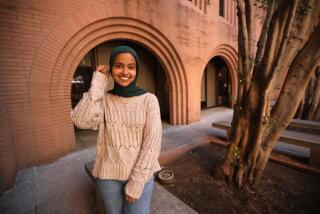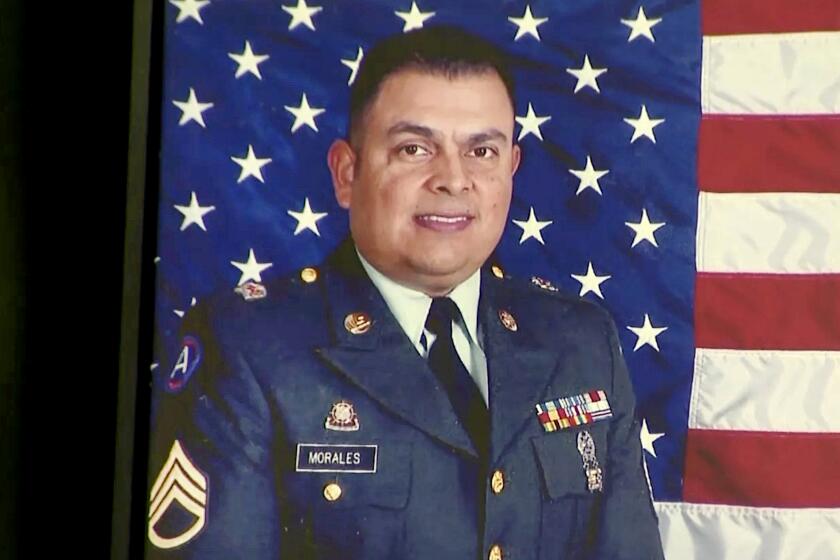TOW student with health challenges honored for ‘overcoming great odds’
Top of the World Elementary School student Grace Farrington is not one to call attention to herself. The fifth-grader lets her smile and actions do the talking.
But Grace, 10, has learned to speak up about a disease she battles every day.
Grace was diagnosed when she was 2 with Type 1 diabetes, which is usually seen in children and young adults and was previously called juvenile diabetes. The condition, which occurs when the pancreas no longer produces insulin, has not stopped her from participating in regular childhood activities.
The Assn. of California School Administrators honored Grace and 28 other Orange County students with the Every Student Succeeding award March 11 during a ceremony at the Bowers Museum in Santa Ana.
The award recognizes students “overcoming great odds to be successful,” said Jan Billings, executive director of the association’s Orange County region.
“This program is the most rewarding event ACSA holds,” Billings said. “These kids overcome unbelievable odds, physical, emotional…. With the help of a support team on campus, they stick to it.”
Top of the World Principal Mike Conlon shared Grace’s story with district administrators, and they selected Grace as the Laguna Beach Unified School District’s representative.
“She’s grown over the years at TOW and excelled with her condition,” said Leisa Winston, the district’s communications and human resources director.
*
Drinking a lot of water and lethargic
Ronda Farrington, Grace’s mother, noticed changes in behavior when Grace was 2.
The girl started drinking a “tremendous amount” of water and “was going through diapers like crazy,” Ronda said.
When news came that Grace had Type 1 diabetes, also previously known as insulin-dependent diabetes, Ronda said she was “devastated.”
“She was only 2 … now she was going to have a disease that is managed so closely,” the mother said. “It took a little bit [of time] to get over that.”
The body needs insulin to transfer glucose from the bloodstream into cells, where it converts into energy.
For the first year, Grace received two or three injections of insulin a day.
She was only 2 ... now she was going to have a disease that is managed so closely. It took a little bit [of time] to get over that.
— Ronda Farrington, Grace’s mother
But by age 3, her parents had switched to an insulin pump that sits inside a pouch attached to Grace’s waist. With the press of a button, the pump delivers the hormone into Grace’s body through a tube attached by a needle inserted into the skin.
Twice a day — at mid-morning break and lunch — TOW’s health clerk Paula Forino watches Grace as she programs into the device the needed amount of insulin to mesh with her food intake.
“[Grace] then tells the pump how much her blood sugar is and enters the amount of carbs she will be eating, and the pump calculates how much insulin is needed to cover,” Ronda said in a follow-up email.
Less than two years ago, Grace started wearing a blood glucose monitor on her upper arm, allowing her to track sugar levels without pricking her finger to draw blood.
Every five minutes, the monitor provides a reading of Grace’s blood sugar. Ronda can check Grace’s glucose levels via an app on her cellphone, and Grace also has a phone with a transmitter so she can see the numbers.
Grace keeps a bottle of glucose tabs with her in case her blood sugar drops, as it did one recent morning.
Grace had finished exercising during physical education class when she felt tired, dizzy and hungry. Her blood sugar plummeted to 41 milligrams per deciliter of blood. The American Diabetes Assn. considers 80 to 130 a target range before a meal.
“I had never seen her face like that,” said Azadeh Baghai, Grace’s teacher. “It was white as a ghost. It was scary.”
Another teacher arrived, as did Forino, who alerted Ronda.
They discussed what to do. Grace sat down, took a glucose tab and in 10 to 15 minutes felt normal.
“I’ll check the sensor, text my mom or call the health aide and, depending on what they say, eat something,” Grace said in explaining the process when she senses her glucose levels dropping.
Baghai said Grace is proactive in communicating to teachers and staff about her condition.
“She is so self-sufficient and quick to tell me if [her blood sugar] is low or high,” Baghai said, adding that other TOW teachers and staff keep tabs on Grace throughout the day too.
“My role is to make sure she is safe and all adults on campus work as a team to make her feel safe,” Baghai said.
*
Taking the initiative
At the beginning of the year, Grace read a children’s book that explained diabetes to her classmates.
Baghai said it helped them understand why Grace is allowed, unlike them. to carry a cellphone.
“[The book] refers to needing to check her blood sugar as well as us being really careful about what treats we serve in class for parties and making sure no one ever shares food with her, which is a school rule anyhow,” Baghai said in a follow-up email.
Sharing about diabetes, though, is not off-limits.
Two months ago, a Russian student with Type 1 diabetes enrolled in Baghai’s class. Grace welcomed the student and made her feel comfortable, Baghai said.
“[Grace] was unbelievable with her,” Baghai said, adding that the student came from a school whose administrators were not familiar with handling children with diabetes.
Ten of Laguna Beach Unified School District’s 3,025 total students have Type 1 diabetes, Winston said.
Diabetes, including Type 2, when the body does not use insulin properly and can’t make enough to keep a person’s blood sugar at a normal reading, has become more prevalent in the U.S. in the last 35 years.
From 1980 through 2014, the number of Americans diagnosed with the disease increased from 5.5 million to 22 million, according to the Centers for Disease Control and Prevention.
Grace participates in dance competitions through South Coast Conservancy and has learned to manage her diet, focusing on portion sizes rather than abstaining from particular foods.
“We stay as low carb as possible,” Ronda said. “We don’t restrict her. We monitor the quantity. Instead of a huge piece of cake with icing, we’ll take half a piece without icing.”
Grace added: “I eat normally. I don’t eat a ton of sugar.”
“She is still a good student, has lots of friends,” Ronda said. “She’s got a crazy disease, but she is still a normal kid.”
More to Read
Start your day right
Sign up for Essential California for news, features and recommendations from the L.A. Times and beyond in your inbox six days a week.
You may occasionally receive promotional content from the Los Angeles Times.







